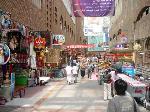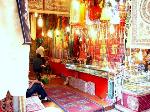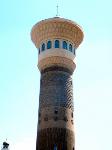- Getting around Lijiang. Dont stay in the Old Towns more than 2 days, there is nothing to do. KRISS Oct 9, 2013 05:46
- 2013 Beijing Temple Fair BENNYLAU Feb 26, 2013 03:29
- Malaysian traveling from KUL - LAX vis Shanghai PVG ZATI_DY Jan 3, 2013 20:15
Urumqi: How Bazaar!
- Views: 11644
- |Vote: 0 0
- |Add to Favorites
- |Recommend to Friends
Urumqi, the capital of Xinjiang, is not a common destination on every traveler's "to-visit" list. Frankly there's not too much interest in the one thing that has put Urumqi on the map, or more precisely into the Guinness Book of World Records - the fact that it is the most remote city from any major body of water in the world (2,500km). No doubt officials at the travel bureau scratch their heads in bewilderment trying to figure out how to best use this designation as the most inland city to their advantage. Fortunately for them Urumqi does have its fair share of beautiful scenic spots and must-see parks including the Heavenly Lake and Red Mountain Park, but what sets this city apart, and what I find myself observing today, is its unique diversity.
I can't help but notice this diversity as I walk down the streets of Urumqi. It's jam packed with people - 2.6 million to be precise, which is not unlike most Chinese cities I've visited - but there's something different with this city. It feels as though I'm wandering across an international border with every street that I cross. The languages change; the clothes change; even the music changes. And then it changes right back along the next block. According to the 2000 census, Han Chinese make up 75% of these people I see while only 15% are Uyghurs (pronounced "wee-gers") or Kazakhs. I find it very hard to belive those numbers based on the faces I see staring back at me along the road. They all look so different, so foreign, so...not Chinese.
Maybe it has something to do with where I'm walking. I'm heading south right now along a busy road toward what is known as the International Bazaar. The closer I get the more people I must squeeze through, wait behind, or otherwise shove to keep myself moving along. Many of them are trying to sell me small trinkets laid out on the ground, clothes folded on a cart or a carpet hanging inside their small shop and I feel guilty for the small pleasure I get listening to their heavily accented Chinese. Just like me they are forced to use a language that is not even close to their native tongue and if I sound half as funny to them as they do to me its a wonder we both don't just bust out laughing.
Thankfully I'm following a map as I walk south, because if my nose were the guide who knows where I'd end up. Smells of spicy roasted ka-bob mix with the soothing aroma of freshly baked bread and I can't help but turn my head to find its source. Along the way I pass noodle stands, bread stands, ka-bob stands, fresh fruit stands, and even Uyghur ice cream stands. These sellers don't yell quite as much, but then again they don't have to because they know the smells do all the talking. I know where I'm headed today but nobody is waiting for me at my destination so I might as well make a quick stop for lunch at a small noodle shop. They have no menu and they really don't even need one - I just point to the ke-bobs being roasted nearby, give a hand signal to communicate how many, and then ask for a plate of their noodles, or "mian". One last point of the finger and I am served a hot piece of traditional bread covered in beautiful mosaic patterns I'm beginning to see a lot around here. Many western restaurants could learn from the speed with which they serve food in these small restaurants, but on the other hand my guess is that most of these places couldn't pass a health inspection imposed on all western diners. I know I'm taking a small risk eating here, but it's good none the less.
Ok, enough of this lolly-gagging. I'm determined to make it past these shops, restaurants, and surprisingly even a few dirty camels to a place where the buildings take on an architectural style completely different than the Chinese which I am accustomed to seeing. In big, bold letters across the side of a large building I see the words "Urumqi International Bazaar" and around the next corner the bazaar square finally opens up to me. The open space is like a breath of fresh air after the crowds I had to endure to get here, but to be honest the scene in front of me is nothing spectacular. The architecture is distinctive but not beautiful, the air is open but still not clean. I wouldn't say that I'm disappointed, but I also wasn't expecting to be awe-struck by the Bazaar.
This Bazaar represents something that has been happening in this area since the Silk Road first came through: trade. Hidden behind the walls of this square, many stories high and even underneath my feet are scores of merchants selling goods from every imaginable eastern country. Clothes, rugs, knives, instruments - ironically enough the only thing to remind me that I am still standing on Chinese soil is the fact that all the sellers I see here are Chinese. It's difficult to imagine yet impossible not to notice that all of the stores leading up to the Bazaar were manned by minorities while all the stores inside the Bazaar are cared for by mostly Chinese. The biggest restaurant, located in the middle of the square, is a KFC for goodness sakes! It only serves to confirm the fact that this is, indeed, an international bazaar.
It seems that there are only a few things that can be done here. One, obviously, is to shop. Most of the items here are suited to tourist (as are the prices), but I'm ok with that because some things can also be difficult to find a good selection of elsewhere. My favorite are the colorful knives. They carry a variety of pocket knives, hand knives, and even a decorative sword or two all crafted in the Uyghur tradition. These make great gifts for friends back at home as long as I remember to pack them in my check-in luggage.
Its also fun to note that the tourist can actually go to the top of the large minaret located in the middle of the Bazaar which is no longer used to call the faithful to prayer. For a fee of 20 yuan you will be taken via an elevator to the viewing deck of the Bazaar minaret where you can soak in a 360 degree view of Urumqi. Climb a few more stairs to see black and white photographs of Urumqi before 1949, back when the city was still named Dihua and the population was less than 100,000. The view from here is nice, but probably not worth the money I paid to enter. I feel like I'd be better off riding the ferris wheel in Red Mountain park if I'm looking too see the city from high above the ground.
After only an hour or two of wandering around I begin to realize that I won't be able to see everything here. There are numerous shops, a nearby mosque I can visit, and even the Xinjiang Silk Road Museum nearby. I'm experiencing mild symptoms of culture shock here and I'm surprisingly ready to get back to the familiarity of the China I though I was visiting. My legs are getting tired now and I'm ready to get back into my air conditioned room. Plus, as good a memory as those noodles were I think they are beginning to take their toll on my digestive system...
Travel Information
Multiple buses make a stop nearby the Urumqi International Bazaar and I honestly couldn't tell you each one. Your best bet might be to just ask your hotel or travel guide which bus number to take from where ever you are staying. If you're not up for a crowded bus (and in Urumqi, they are all crowded), a taxi is just as simple and not very expensive. The International Bazaar is located in the southern part of the main city of Urumqi about 2km from the people's square.
As stated above, all is free to see and do with the exception of:
Bazaar Minaret: 20 RMB
Silk Road Museum: 30 RMB
All shopping: As much RMB as they can milk you for!!








 Copyright © 1998-2025 All rights reserved.
Copyright © 1998-2025 All rights reserved.
1.
Aug 10, 2008 21:23 Reply
JSUMMERS83 said:
Thanks for the comment! In reply to your comments:
1) I love Xinjiang, but no, the Bazaar isn't my favorite place to visit. It's too "touristy".
2) Xinjiang food is THE BEST! Hands down.
3) I liked seeing the city from above. However, I paid 20 yuan at the Bazaar...you can do it free at the Red Mountain Park.
4) Xinjiang is the far northwest part of China...quite far from any coast, as noted in the review.
Thanks!
2.
Aug 8, 2008 15:23 Reply
KRATERON said:
JSUMMERS83.. my interpretation of the text:
You didn't like the place, right?
I guess food was the best part after all :)
Why didn't you like to see city from above?
Is it located in the intern part of China, or coastal part of China?
thanks for sharing the experience!